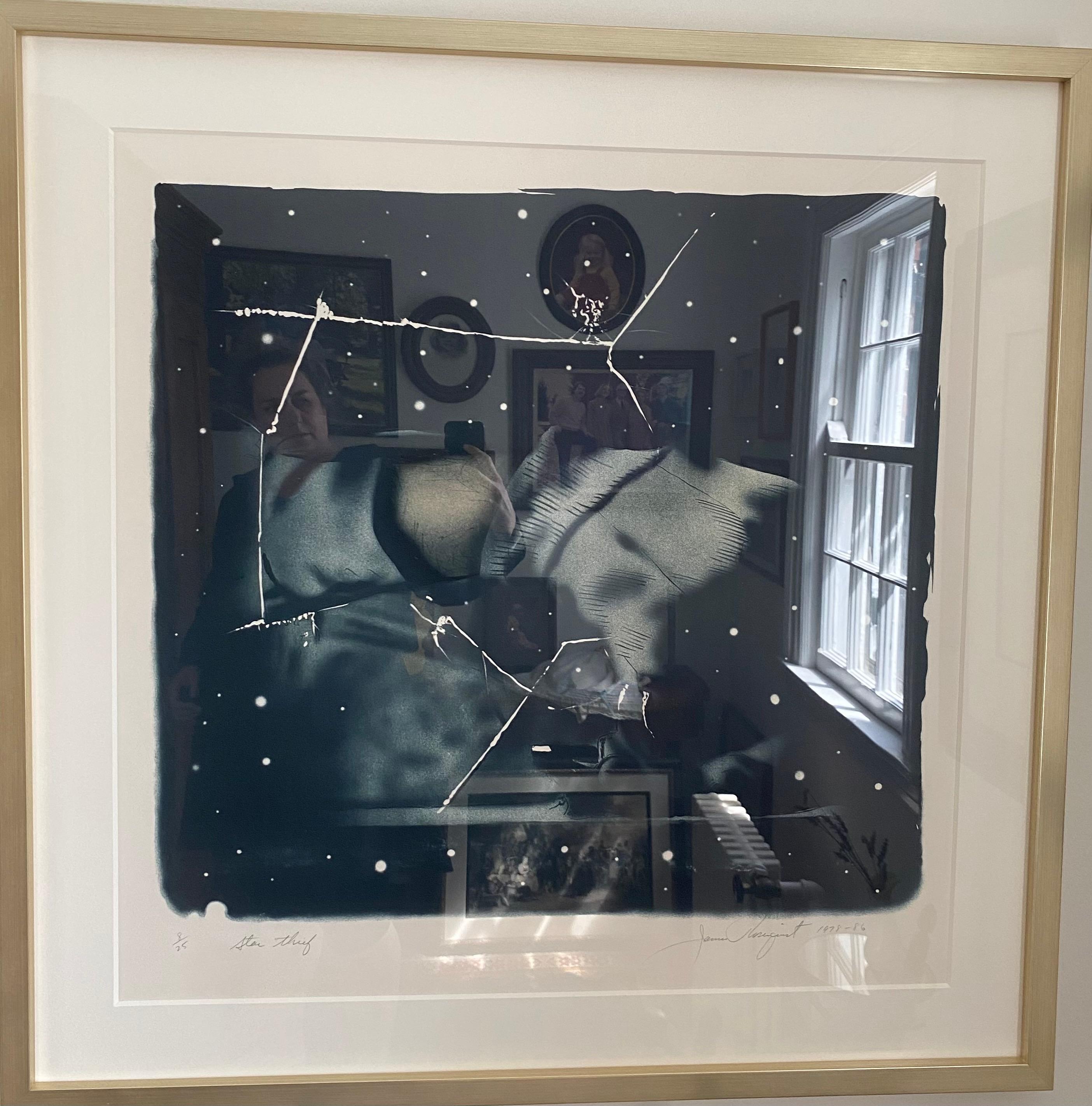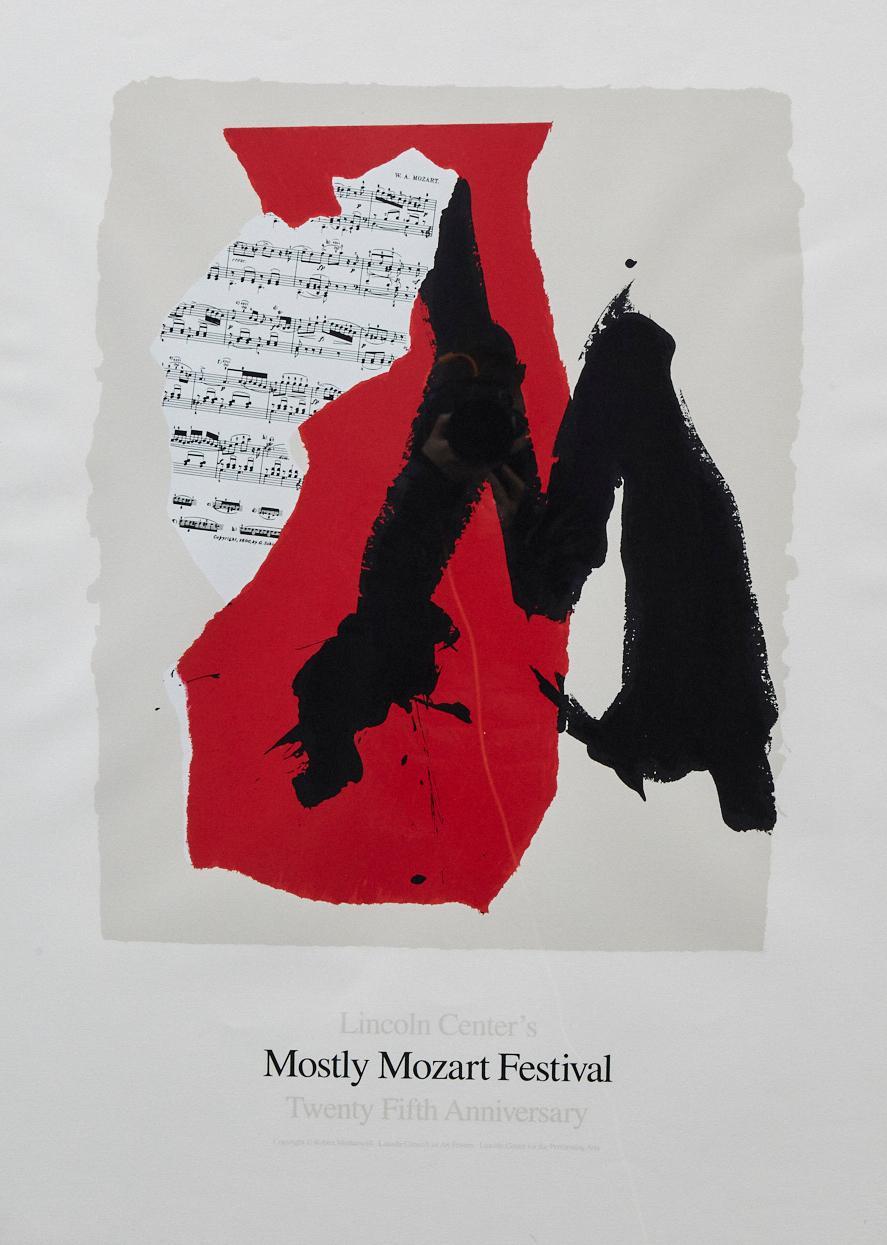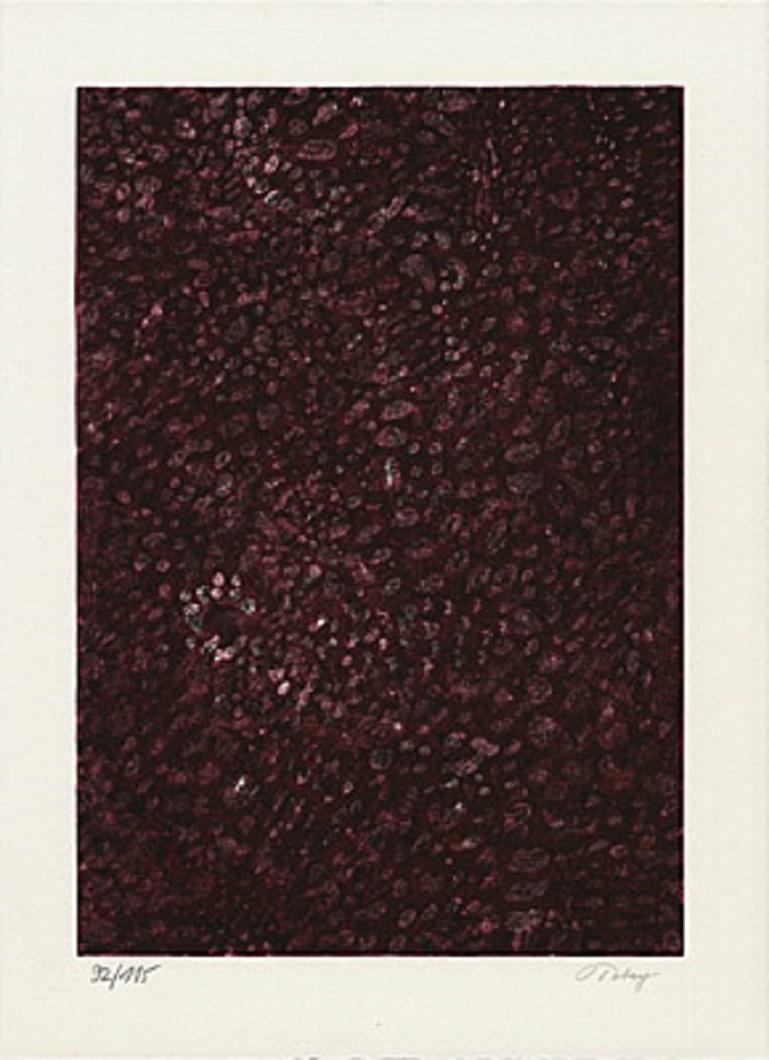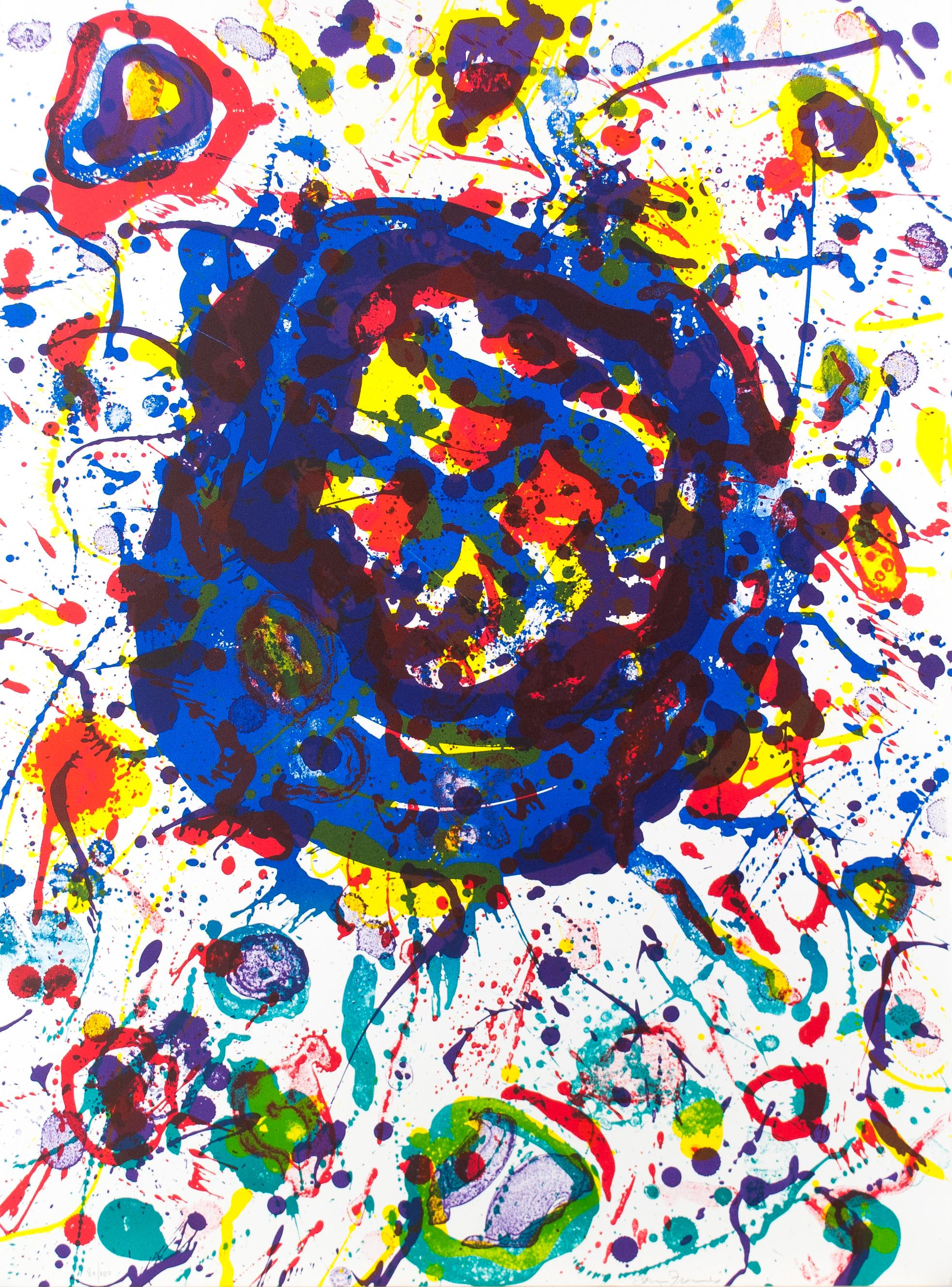Items Similar to Pietro Consagra Italian Mod Abstract Expressionist Forma Art Informel Lithograph
Want more images or videos?
Request additional images or videos from the seller
1 of 12
Pietro ConsagraPietro Consagra Italian Mod Abstract Expressionist Forma Art Informel Lithograph1960's-1970's
1960's-1970's
About the Item
Pietro Consagra (Italian, 1920-2005).
Hand signed in pencil and numbered limited edition color lithograph on Magnani paper.
Embossed stamp with limited edition numbers in pencil to lower left, and having artist pencil signature to lower right.
(from a limited edition of 80 with 15 artist's proofs)
Published by Stamperia 2RC, Rome Italy and Marlborough Gallery, Rome, Italy.
Abstract Modernist work in colors, produced in the style of the Forma art movement of Postwar Italy, of which the artist was a prominent member.
Pietro Consagra (1920 – 2005) was an Italian Post war artist working in painting, printmaking and sculpture. In 1947 he was among the founding members of the Forma 1 group of artists, proponents of structured abstraction. (similar to the Art Informel and Art Brut in France and the Brutalist artists)
Consagra was born on 6 October 1920 in Mazara del Vallo, in the province of Trapani in south-western Sicily, to Luigi Consagra and Maria Lentini. From 1931 he enrolled in a trade school for sailors, studying first to become a mechanic, and later to become a captain. In 1938 he moved to Palermo, where he enrolled in the liceo artistico; despite an attack of tuberculosis, he graduated in 1941, and in the same year signed up at the Accademia di Belle Arti, where he studied sculpture under Archimede Campini. After the Invasion of Sicily and the Allied occupation of Palermo in 1943, Consagra found work as a caricaturist for the American Red Cross club of the city; he also joined the Italian Communist Party. Early in 1944, armed with a letter of introduction from an American officer, he travelled to Rome. There he came into contact with the Sicilian artist Concetto Maugeri, and through him with Renato Guttuso, who was also Sicilian and who introduced him to the intellectual life of the city and to other postwar artists such as Leoncillo Leonardi, Mario Mafai and Giulio Turcato. Consagra signed up at the Accademia di Belle Arti di Roma in September 1944 and studied sculpture there under Michele Guerrisi, but left before completing his diploma.
In 1947, with Carla Accardi, Ugo Attardi, Piero Dorazio, Mino Guerrini, Achille Perilli, Antonio Sanfilippo and Giulio Turcato, Consagra started the artist's group Forma 1, which advocated both Marxism and structured abstraction.
Steadily Consagra's work began to find an audience. Working primarily in metal, and later in marble and wood, his thin, roughly carved reliefs, began to be collected by Peggy Guggenheim and other important patrons of the arts. He showed at the Venice Biennale eleven times between 1950 and 1993, and in 1960 won the sculpture prize at the exhibition. During the 1960s he was associated with the Continuità group, an offshoot of Forma I, and in 1967 taught at the School of Arts in Minneapolis. Large commissions allowed him to begin working on a more monumental scale, and works of his were installed in the courtyard of the Foreign Ministry in Rome and in the European Parliament, Strasbourg. His work is found in the collections of The Tate Gallery, London, in Museo Cantonale d'Arte of Lugano and the Museum of Modern Art, Paris, and the National Gallery of Art in Washington, D.C..
Consagra returned to Sicily where he sculpted a number of significant works during the 1980s. With Senator Ludovico Corrao, he helped created an open-air museum in the new town of Gibellina, after the older town had been destroyed in the earthquake of 1968. Consagra designed the gates to the town's entrance, the building named "Meeting" and the gates to the cemetery, where he was later buried.
In 1952 Consagra published La necessità della scultura ("the need for sculpture"), a response to the essay La scultura lingua morta ("sculpture, a dead language"), published in 1945 by Arturo Martini. Other works include L'agguato c'è ("the snare exists", 1960), and La città frontale ("the frontal city", 1969). His autobiography, Vita Mia, was published by Feltrinelli in 1980. In 1989 a substantial retrospective exhibition of work by Consagra was shown at the Galleria Nazionale d'Arte Moderna in Rome; in 1993 a permanent exhibition of his work was installed there. In 1991 his work was shown in the Hermitage Museum in St. Petersburg. In 2002 the Galerie der Stadt Stuttgart opened a permanent exhibition of his work. He was one of ten artists invited by Giovanni Carandente, along with David Smith, Alexander Calder, Arnaldo Pomodoro, Lynn Chadwick, and Beverly Pepper, to fabricate works in Italsider factories in Italy for an outdoor exhibition, "Sculture nella città", held in Spoleto during the summer of 1962. He was included in the The 1962 International Prize for Sculpture the jury included Argan, Romero Brest and James Johnson Sweeney the former director of the Solomon R. Guggenheim Museum in New York. The participants included Louise Nevelson and John Chamberlain for the United States; Lygia Clark for Brazil; Pietro Consagra, Lucio Fontana, Nino Franchina, and Gió Pomodoro for Italy; Pablo Serrano for Spain; and Eduardo Paolozzi, William Turnbull, and Kenneth Armitage for England. Gyula Kosice, Noemí Gerstein, Julio Gero, Naum Knop, Aldo Paparella, Enrique Romano, Eduardo Sabelli, and Luis Alberto Wells represented Argentina.
- Creator:Pietro Consagra (1920 - 2005, Italian)
- Creation Year:1960's-1970's
- Dimensions:Height: 19 in (48.26 cm)Width: 25 in (63.5 cm)
- Medium:
- Movement & Style:
- Period:
- Condition:
- Gallery Location:Surfside, FL
- Reference Number:1stDibs: LU38211460152
About the Seller
4.9
Platinum Seller
These expertly vetted sellers are 1stDibs' most experienced sellers and are rated highest by our customers.
Established in 1995
1stDibs seller since 2014
1,548 sales on 1stDibs
Typical response time: 1 hour
- ShippingRetrieving quote...Ships From: Surfside, FL
- Return PolicyA return for this item may be initiated within 3 days of delivery.
More From This SellerView All
- Pietro Consagra Italian Mod Abstract Expressionist Forma Brutalist LithographBy Pietro ConsagraLocated in Surfside, FLPietro Consagra (Italian, 1920-2005). Hand signed in pencil and numbered limited edition color lithograph on Magnani paper. Embossed stamp with limited edition numbers in pencil to lower left, and having artist pencil signature to lower right. (from a limited edition of 80 with 15 artist's proofs) Published by Stamperia 2RC, Rome Italy and Marlborough Gallery, Rome, Italy. Abstract Modernist work in colors, produced in the style of the Forma art movement of Postwar Italy, of which the artist was a prominent member. Pietro Consagra (1920 – 2005) was an Italian Post war artist working in painting, printmaking and sculpture. In 1947 he was among the founding members of the Forma 1 group of artists, proponents of structured abstraction. Consagra was born on 6 October 1920 in Mazara del Vallo, in the province of Trapani in south-western Sicily, to Luigi Consagra and Maria Lentini. From 1931 he enrolled in a trade school for sailors, studying first to become a mechanic, and later to become a captain. In 1938 he moved to Palermo, where he enrolled in the liceo artistico; despite an attack of tuberculosis, he graduated in 1941, and in the same year signed up at the Accademia di Belle Arti, where he studied sculpture under Archimede Campini. After the Invasion of Sicily and the Allied occupation of Palermo in 1943, Consagra found work as a caricaturist for the American Red Cross club of the city; he also joined the Italian Communist Party. Early in 1944, armed with a letter of introduction from an American officer, he travelled to Rome. There he came into contact with the Sicilian artist Concetto Maugeri, and through him with Renato Guttuso, who was also Sicilian and who introduced him to the intellectual life of the city and to other postwar artists such as Leoncillo Leonardi, Mario Mafai and Giulio Turcato. Consagra signed up at the Accademia di Belle Arti di Roma in September 1944 and studied sculpture there under Michele Guerrisi, but left before completing his diploma. In 1947, with Carla Accardi, Ugo Attardi, Piero Dorazio, Mino Guerrini, Achille Perilli, Antonio Sanfilippo and Giulio Turcato, Consagra started the artist's group Forma 1, which advocated both Marxism and structured abstraction. Steadily Consagra's work began to find an audience. Working primarily in metal, and later in marble and wood, his thin, roughly carved reliefs, began to be collected by Peggy Guggenheim and other important patrons of the arts. He showed at the Venice Biennale eleven times between 1950 and 1993, and in 1960 won the sculpture prize at the exhibition. During the 1960s he was associated with the Continuità group, an offshoot of Forma I, and in 1967 taught at the School of Arts in Minneapolis. Large commissions allowed him to begin working on a more monumental scale, and works of his were installed in the courtyard of the Foreign Ministry in Rome and in the European Parliament, Strasbourg. His work is found in the collections of The Tate Gallery, London, in Museo Cantonale d'Arte of Lugano and the Museum of Modern Art, Paris, and the National Gallery of Art in Washington, D.C.. Consagra returned to Sicily where he sculpted a number of significant works during the 1980s. With Senator Ludovico Corrao, he helped created an open-air museum in the new town of Gibellina, after the older town had been destroyed in the earthquake of 1968. Consagra designed the gates to the town's entrance, the building named "Meeting" and the gates to the cemetery, where he was later buried. In 1952 Consagra published La necessità della scultura ("the need for sculpture"), a response to the essay La scultura lingua morta ("sculpture, a dead language"), published in 1945 by Arturo Martini. Other works include L'agguato c'è ("the snare exists", 1960), and La città frontale ("the frontal city", 1969). His autobiography, Vita Mia, was published by Feltrinelli in 1980. In 1989 a substantial retrospective exhibition of work by Consagra was shown at the Galleria Nazionale d'Arte Moderna in Rome; in 1993 a permanent exhibition of his work was installed there. In 1991 his work was shown in the Hermitage Museum in St. Petersburg. In 2002 the Galerie der Stadt Stuttgart opened a permanent exhibition of his work. He was one of ten artists invited by Giovanni Carandente, along with David Smith, Alexander Calder, Arnaldo Pomodoro, Lynn Chadwick, and Beverly Pepper, to fabricate works in Italsider factories in Italy for an outdoor exhibition, "Sculture nella città", held in Spoleto during the summer of 1962. He was included in the The 1962 International Prize for Sculpture the jury included Argan, Romero Brest and James Johnson Sweeney the former director of the Solomon R. Guggenheim Museum in New York. The participants included Louise Nevelson and John Chamberlain for the United States; Lygia Clark for Brazil; Pietro Consagra, Lucio Fontana, Nino Franchina, and Gió Pomodoro for Italy; Pablo Serrano for Spain; and Eduardo Paolozzi, William Turnbull, and Kenneth Armitage for England. Gyula Kosice, Noemí Gerstein, Julio Gero, Naum Knop...Category
1960s Abstract Expressionist Abstract Prints
MaterialsLithograph
- 1960's California Pop Art Abstract Expressionist LA Lithograph "About Women"Located in Surfside, FLJohn Altoon (1925 - 1969), an American artist, was born in Los Angeles to immigrant Armenian parents. From 1947–1949 he attended the Otis Art Institute, fr...Category
1960s Abstract Expressionist Abstract Prints
MaterialsLithograph
- Bright Vibrant Pop Art Silkscreen Lithograph Print NYC Abstract ExpressionistBy William ScharfLocated in Surfside, FLRed Angel, intensely and seductively colored: swooning purples and reds, ecstatic lemon yellows, and black construction paper. Jostling shapes, geometric and biomorphic, lyrical and hard-edged, refuse to resolve neatly Assemblage, a bold strategy to keep viewers unsettled and curious, the reward for which are profuse and luscious details: varied incidents of refinement, suggestive signs, most in a private code, not merely ornamental but integral to the overall message. William Scharf (born 1927, Media, PA) is an American artist from New York, he teaches at The Art Students League of New York. Painting with acrylics, he was a member of the New York School movement. Often categorized as a late generation Abstract Expressionist, Known for producing paintings with abstract compositions incorporating biomorphic and geometric forms in vivid colors, the artist was influenced by Surrealism, the Color Field painters, and symbolism. He apprenticed with Mark Rothko and was influenced by his color field paintings. The surrealist painter Arshile Gorky and the Abstract expressionism style found in 1950s New York City also influenced Scharf. His exhibits include San Francisco Art Institute (1969), the Pepperdine University's Frederick R. Weisman Museum of Art (2001), and Richard York Gallery in New York City (2004). In the heyday of Abstract Expressionism, being serious meant following the tenets of the New York School, which required abstract paintings to be spontaneous improvisations, the messier the better. At once hedonistic and disciplined, his brazen paintings are nothing if not promiscuous. The best ones mix the dynamism of gestural abstraction with sensual rhythms of decorative patterning, sometimes souping up the stew with cartoonish symbols and flourishes so ripe they belong in a dandy's fantasies. His exhibits include San Francisco Art Institute (1969), the Pepperdine University's Frederick R. Weisman Museum of Art (2001) and Richard York Gallery in New York City (2004). Scharf's work has been exhibited in a number of galleries, including the Anita Shapolsky Gallery, Meredith Ward Fine Art, and Hollis Taggart Galleries in New York City. Scharf has been an instructor of art at various institutions including The Art Students League, the San Francisco Art Institute, and the School of Visual Arts in New York. He is a member of the Society of Illustrators and the Artists Equity Association. EDUCATION 1944-49 The Pennsylvania Academy of the Fine Arts — Philadelphia, PA (1948 Cresson Scholar) 1949 The University of Pennsylvania — Philadelphia, PA 1948 The Academie de la Grand Chaumiere — Paris, France 1947 The Barnes Foundation — Merion, PA 1939-41 Samuel Fleisher Memorial School— Philadelphia, PA (also known as Graphic Sketch Club) TEACHING HISTORY Instructor: Painting & Drawing 1987-Present Art Students League, New York, NY 1989, 74, 69, 66, 63 San Francisco Institute of Fine Arts, San Francisco, CA 1965-69 he School of Visual Arts, New York, NY 1964 Art Center of the Museum of Modern Art, New York, NY Guest Lecturer 1979 Pratt Institute, New York, NY 1974 Stanford University, Palo Alto, CA 1974 California College of Arts and Crafts, San Francisco, CA Recent Solo Exhibitions: 2005 Meredith Ward Fine Art, New York, NY 2004 Richard York Gallery, New York, NY 2002 P.S.1/MOMA, Queens, NY 2001 The Frederick R. Weisman Museum of Art, Malibu, CA 2000-2001 The Phillips Collection, Washington, DC Selected Group Exhibitions: 2005 National Academy of Design, New York, NY 2005 Peter McPhee Fine Arts, Stone Harbor...Category
1970s Abstract Expressionist Abstract Prints
MaterialsLithograph, Screen
- Large 1960's California Pop Art Abstract Expressionist LA Lithograph John AltoonLocated in Surfside, FLJohn Altoon (1925-1969) UNTITLED, 1966, color lithograph, hand signed in pencil and inscribed trail proof II, sheet 29 ¾ x 41 ¼, printed by Gemini G.E.L.,...Category
1960s Abstract Expressionist Abstract Prints
MaterialsLithograph
- Israeli Modern Pop Art Photo Silkscreen Serigraph Abstract Paint Sheep KadishmanBy Menashe KadishmanLocated in Surfside, FLMenashe Kadishman was born in Tel-Aviv in 1932. He is a Graduate of St. Martin's School of Art, University of London Studies with Anthony Caro, Reg Butler. From 1947 to 1950, Kadish...Category
1980s Abstract Expressionist Landscape Prints
MaterialsLithograph, Screen
- Cobra Artist 1950s Silkscreen Serigraph Bright Colorful Abstract Hand SignedBy Erling JorgensenLocated in Surfside, FLSmall vintage hand signed and dated graphic. limited edition. Erling Jørgensen, 1905-1977 Born in Denmark, self taught artist. painter and graphic. print-maker. Danish painter and gr...Category
1950s Abstract Expressionist Abstract Prints
MaterialsLithograph
You May Also Like
- "The Star Thief" by James RosenquistBy James RosenquistLocated in Hinsdale, ILJames Rosenquist (1933-2017) Star Thief Color lithograph on white wove paper, 1978-1986 Image size: 31.75” x 32”, full margins. Impression 8 of edition of 25 Signed, titled, da...Category
1980s Abstract Expressionist Abstract Prints
MaterialsLithograph
- Untitled from "Vingt-deux poèmes" by Mark Tobey, Lithography, Cassou, Black, RedBy Mark TobeyLocated in Köln, DEColor lithograph by Mark Tobey (Centerville, Wisconsin 1890 - 1976 Basel) from "Vingt-deux poèmes" (Portfolio with artworks by several artists and 22 poems by Jean Cassou...Category
1960s Abstract Expressionist Abstract Prints
MaterialsLithograph
- Untitled from the portfolio “Poems dans le ciel”By Sam FrancisLocated in Ljubljana, SIPoems dans le ciel (eng. Poems in the sky). Original lithograph, 1986. Edition of 100 signed and numbered impressions on Arches paper. Samuel Lewis Francis was an American artist, we...Category
1980s Abstract Expressionist Abstract Prints
MaterialsLithograph
- Untitled (Fresh Air School) /// Abstract Expressionist Female Joan Mitchell ArtBy Joan MitchellLocated in Saint Augustine, FLArtist: Joan Mitchell (American, 1925-1992) Title: "Untitled (Fresh Air School)" Portfolio: Fresh Air School *Unsigned edition Year: 1972 Medium: Orig...Category
1970s Abstract Expressionist Abstract Prints
MaterialsLithograph, Offset
- Untitled (SF-348) (Fresh Air School) /// Abstract Expressionist Sam Francis ArtBy Sam FrancisLocated in Saint Augustine, FLArtist: Sam Francis (American, 1923-1994) Title: "Untitled (SF-348) (Fresh Air School)" Portfolio: Fresh Air School *Unsigned edition Year: 1972 Mediu...Category
1970s Abstract Expressionist Abstract Prints
MaterialsLithograph, Offset
- Casino Knokke Poster (Signed) /// Contemporary Abstract Sculpture Frank StellaBy Frank StellaLocated in Saint Augustine, FLArtist: (after) Frank Stella (American, 1936-) Title: "Casino Knokke" Series: Casino Knokke Posters *Signed by Stella in black marker lower center Year: 1991 Medium: Original Offset-Lithograph, Exhibition Poster on glossy wove paper Limited edition: Unknown Printer: Unknown Publisher: Casino Knokke, Knokke, Belgium Sheet size: 24.5" x 16.63" Condition: Some minor handling creases. In excellent condition Very rare Notes: Provenance: private collection - Paris, France; acquired directly from the exhibition at Casino Knokke, Knokke, Belgium. Poster produced for a special exhibition of Stella's work at Casino Knokke, Knokke, Belgium from June 23 - September 1, 1991. The artwork featured on this poster is Stella's 1991, 133" x 87" x 75" stainless steel, bronze, copper, aluminum and carbon steel sculpture "Raft of the Medusa, Part IV". Comes with its rare 56 page softcover exhibition catalogue "Frank Stella: Casino Knokke" featuring 18 artworks. GIA Gallery Poster Disclaimer: Not to be confused with thousands of contemporary inkjet/giclée/digital reproductions ignorantly or deliberately passed off as originals on the market today. The examples we offer here are the original period vintage (exhibition) posters, created and designed by, or under the supervision and authorization of the artist or their respective estate (posthumously), for various exhibitions and events in which they participated. If applicable, this poster is also fully documented within its respective artists' official catalogue raisonné of authentic graphic works, prints, and or posters. Biography: Frank Stella (1936-) is an American artist best known for his use of geometric patterns and shapes in creating both paintings and sculptures. Arguably one of the most influential living American artists, Stella’s works utilize the formal properties of shape, color, and composition to explore non-literary narratives, as seen in his work Harrar II (1967) from the Protractor series. “Abstraction didn't have to be limited to a kind of rectilinear geometry or even a simple curve geometry. It could have a geometry that had a narrative impact. In other words, you could tell a story with the shapes,” he explained. “It wouldn't be a literal story, but the shapes and the interaction of the shapes and colors would give you a narrative sense. You could have a sense of an abstract piece flowing along and being part of an action or activity.” Born on May 12, 1936 in Malden, MA, Stella went on to study history at Princeton University before moving to New York in 1958. Having moved to the city, Stella was immersed in the heyday Abstract Expressionism, but it was the work of Jasper Johns that inspired Stella’s Black...Category
1990s Abstract Expressionist Abstract Prints
MaterialsLithograph, Offset, Permanent Marker
Recently Viewed
View AllMore Ways To Browse
Vintage Western Art Prints
Mod Art
Mod 1970s
Italian Lithographs Rome
Large Scale Lithographs
Lithograph Large Scale Lithograph
Postwar Art
Retro Mod Style
Large Scale Art Western
French Mod
Embossed Lithograph
Lithograph Embossment
Petersburg Lithograph
1970 Art Marble
Mod Prints
Vintage Forma
William A Clark
Clarks England





